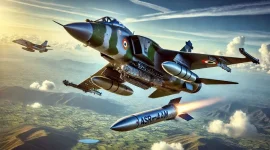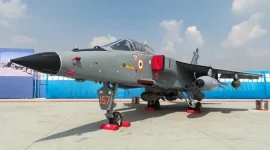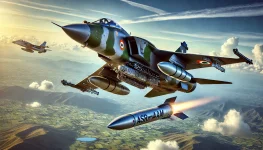- Views: 2K
- Replies: 12
The Indian Air Force (IAF) is making waves with its upgraded Jaguar DARIN III fighter-bombers, armed with long-range Rampage missiles. This combination presents a potential game-changer in the ongoing chess match between India and Pakistan's air power capabilities.
The Upgraded Predator: Jaguar DARIN III
In the world of military aviation, upgrades can mean the difference between a routine flight and a decisive victory. The Jaguar DARIN III isn't your grandpa's fighter jet. With souped-up avionics and navigation systems, it's like giving an old sports car a high-tech makeover.But what really makes it stand out is its new weapon of choice: the Rampage missile. This isn't your average air-to-ground missile; it's a long-range, precision-guided beast. The Jaguar pilot can launch this missile from afar, keeping the aircraft out of harm's way while the Rampage does its deadly work.
The Target: Pakistani Air Defence Systems
Pakistan's air defence network is no slouch. They have a variety of HQ-9 surface-to-air missile (SAM) systems, including mobile and vehicle-mounted versions, all designed to keep enemy aircraft at bay. These systems have varying ranges and altitudes they can cover, creating a multi-layered defensive shield.Think of it like a fortress protecting a valuable city. The different SAM systems are like towers and walls, each covering a different section of the sky.
The Clash: Rampage vs. HQ-9
The Rampage missile is like a skilled archer, carefully aiming its arrows at specific targets. It can neutralize enemy installations with precision, potentially punching holes in Pakistan's defensive fortress.One possible scenario is using the Jaguar DARIN III with Rampage missiles to take out key Pakistani air defense systems before launching a larger air attack. By launching from a distance, the Jaguars can stay safe while clearing a path for other aircraft.
The Uncertain Outcome
While the IAF's new combo pack looks impressive on paper, real-world warfare is messy and unpredictable. The success of such an operation depends on several factors:- Intelligence: The IAF needs to know exactly where the Pakistani SAM systems are located to target them effectively.
- Suppression: The IAF may need to use other aircraft or tactics to distract or overwhelm Pakistani air defenses, giving the Jaguars a better chance to hit their targets.
- Countermeasures: Pakistani air defenses may have their own tricks up their sleeves, like jamming or decoy flares, to throw off the Rampage missiles.
Open-Source Insights
Open-source information reveals that the Rampage missile is a joint venture between Israel Aerospace Industries (IAI) and India's Defence Research and Development Organisation (DRDO). It has a range of over 150 km and can carry a variety of warheads, making it a versatile weapon.The HQ-9 system is a Chinese-made SAM system, similar to the Russian S-300. It has a range of over 100 km and can engage multiple targets simultaneously.
This information paints a clearer picture of the weapons involved in this potential conflict, but it also highlights the complexity of modern warfare. The outcome of a clash between the Jaguar DARIN III with Rampage missiles and Pakistan's HQ-9 SAM systems is far from certain.
The Bottom Line
The IAF's upgraded Jaguars and their new missiles are a powerful tool in their arsenal, but they're not a magic bullet. Whether they can effectively neutralize Pakistani air defenses remains to be seen. One thing is for sure: the stakes are high, and the outcome could have significant implications for the region.Disclaimer: This article is intended for informational purposes only and does not constitute military or political analysis. The views expressed are those of the author and do not necessarily reflect the official policy or position of any government or organization.




